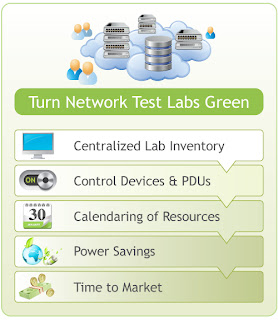– Alex Henthorn-Iwane,
It is a rare case today where you can find an enterprise, service provider or network equipment manufacturer that isn’t under tremendous pressure to increase efficiency and squeeze every last centime of profitability out of the proverbial rock. In that spirit, a common initiative is to find ways to reduce power consumption, since this directly impacts bottom-line operating costs. It also happens to make environmental sense, which the public relations and marketing department can use to bolster the social justice score of the company’s brand.
Test labs are a prime target to “go green” because they consume massive amounts of electricity for the operation and cooling of power-hungry equipment including:
- The devices under test (DUTs) such as switches, routers, and computing and storage servers
- Test generation switches; and
- The equipment that provides connectivity between all the actual testing devices
If reducing the amount of time that test lab equipment spends powered up is the key to reducing power consumption, then it is essential to understand the aspects of typical test lab operational processes that cause test devices to be powered up longer than is truly necessary. One look at the typical test lab and one can see that the lack of information technology-driven automation in the test lab environment is at the root of many inefficiencies in the lab, including power consumption.
No one in the front offices of companies that possess large test labs would consider it efficient to coordinate meetings and resources without a shared calendaring system like Microsoft Exchange, nor would they consider post-it notes to be the state of the art form of messaging. It is laughable to restrict communication in a large office building setting to telephones connected manually by an operator using cables and a physical switchboard. Yet that, in a sense, is the state of business process automation in many test labs. Very costly DUTs and test generators are often connected together with an unruly mess of cables and manual patch panels. Testing teams coordinate their usage of equipment through “hands off” post-it notes placed on equipment that is in use, and through emails. Visibility to and calendaring of resources is typically non-existent as well—it’s all handled in a very manual fashion.
The lack of automation dramatically increases the amount of time it takes to connect test equipment together and to configure the test devices so that they’re ready for testing. Sorting through a spaghetti mess of cables and physically connecting the various test components into a testing topology can take hours or even days. A test engineer may take further hours or days to load the right OS or firmware versions and configure the devices in a large test bed topology. Due to the downside risk of making mistakes during setup and configuration, equipment is often kept locked down and powered up during that entire period. And it gets even worse.
Delivery of the actual software that must be tested is often delayed. Since the time investment just to prepare for the test is so high, engineers often will simply keep test topologies locked up sto avoid the risk of losing access to a critical test component or having their configuration changed. As a result, the ratio of time spent in setup and configuration vs. actual testing can be as lopsided as 80% vs. 20%. From a power consumption and cost containment point of view, this way of doing business presents a huge opportunity for improvement. Lab automation software provides the means to realize that opportunity by changing the way test labs are operated. Lab automation software does this by:
Connecting to and controlling all the equipment in the lab, including all the Power Distribution Units (PDU’s) in the lab, including how the PDUs are connected to each other. This capability enables much better control over power consumption because the lab automation software can easily power on and off required resources, and even manage power as regularly scheduled provisioning procedures in the lab.
Enabling testers to build and schedule the precise resources they need in a test topology, including the design and activation of their connectivity, provisioning of proper OS and firmware versions onto devices, and configuration of logical parameters and features. This advanced scheduling minimizes setup time and wasted powerTracking scheduling and activation indicators of device utilization and test completion providing vital business intelligence reports to help managers and architects continue to refine best practices and continuously improve efficiency.
Ultimately, lab automation is good for saving money on power and cooling and leads to dramatic CAPEX savings, since by increasing device utilization, less costly new equipment needs to be purchased annually. Lab automation’s efficiency benefits also extend to the speed and thoroughness with which testers can complete their test cases, leading to better test coverage, faster time to market and higher initial quality. So, while lab automation software can help turn lab hardware greener in terms of power usage, it can also help deliver more “green” to organizations by delivering better top and bottom-line business results and profitability.
About the Author
Alex Henthorn-Iwane joined QualiSystems in 2013 as Vice-President of Marketing, and is responsible for worldwide marketing and public relations. For more information, please visit http://www.qualisystems.com.





